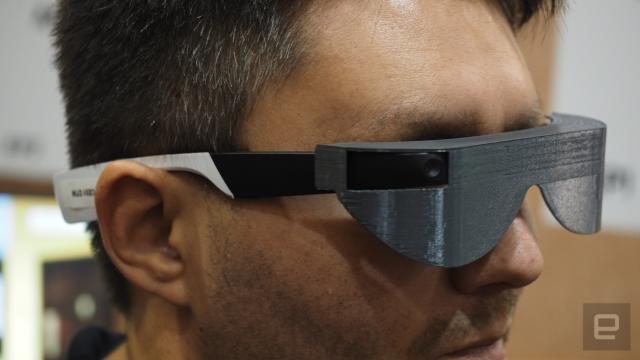Voice-Activated Assistive Devices: Empowering the Visually Impaired Through Innovation
Voice-Activated Assistive Devices: Empowering the Visually Impaired Through Innovation
Blog Article
Discover Advanced Assistive Tools for Individuals With Aesthetic Problems
The landscape of assistive modern technology for individuals with aesthetic disabilities is developing swiftly, providing a range of ingenious devices that boost autonomy and engagement. From wise glasses that flawlessly combine visual input with acoustic advice to sophisticated navigation applications that redefine spatial understanding, these tools are improving opportunities.
Smart Glasses Innovations
Smart glasses represent a significant advancement in assistive innovation for people with aesthetic disabilities. Geared up with sensing units and electronic cameras, wise glasses can capture real-time aesthetic details, which is after that processed and shared to the customer through sound comments or haptic sensations.
Furthermore, innovations in fabricated knowledge have even more enhanced the abilities of wise glasses. Device discovering algorithms can identify faces, read text, and determine items, making them invaluable tools for day-to-day tasks. Customers can receive auditory signs that provide context about their environment, cultivating independence and confidence.
Additionally, the ergonomic layout and light-weight nature of many wise glasses make them appropriate for extended use, ensuring comfort while improving functionality. As these gadgets continue to evolve, they hold the potential to revolutionize the means people with visual problems experience their day-to-days live, linking the void in between availability and technology. The ongoing r & d in this area assurance to broaden the possibilities for wise glasses, making them a necessary element of contemporary assistive devices.
Navigating Apps and Devices
Countless navigating applications and tools have actually become important resources for individuals with aesthetic impairments, dramatically improving their ability to go across unfamiliar atmospheres. These innovations utilize GPS functionality, audio cues, and real-time information to supply users with precise navigating support.
One popular example is the Aira application, which links customers to trained representatives who can offer visual summaries of environments and navigating support with a real-time video clip feed. This service enhances the customer's spatial recognition and self-confidence while navigating. An additional significant device is Seeing Eye GPS, which offers voice-guided navigation and factors of rate of interest, allowing users to accessibility essential information about their surroundings.

As technology remains to development, the growth of extra sophisticated navigating devices assures to more encourage individuals with aesthetic problems, promoting seamless flexibility and assimilation right into varied settings. Such technologies contribute in promoting a much more comprehensive culture.
Braille Innovation Improvements
Over the last few years, developments in Braille innovation have actually substantially transformed just how people with aesthetic problems access information and engage with the globe around them. The development of portable Braille display screens has revolutionized reading by enabling users to link wirelessly to tablet computers, computer systems, and smart devices. These tools convert message right into Braille in real-time, allowing smooth interaction with electronic content.
Furthermore, innovative Braille printers have arised, boosting the production of tactile products. Modern embossers are quicker and more effective, enabling the rapid creation of Braille papers and Screen readers for the blind instructional products. This performance lowers the moment and expense related to creating Braille sources, making them much more available to companies and institutions.
Furthermore, the assimilation of Braille with various other innovations, such as expert system and device discovering, has opened up brand-new methods for tailored learning experiences. Voice recognition and synthesis innovations can complement Braille, providing an inclusive strategy to details dissemination.
As the demand for inclusive education and work environment atmospheres expands, these technological improvements play an essential function in empowering people with aesthetic disabilities, ensuring they have equal access to info and possibilities in various elements of life.
Wearable Tools for Independence
An expanding array of wearable tools is improving independence for people with aesthetic impairments, offering innovative solutions that improve navigation and day-to-day living. Braille displays and notetakers. These devices utilize sophisticated modern technologies to provide real-time feedback and support, promoting freedom in different atmospheres

Wearable technology additionally includes smartwatches that can be programmed with access attributes, allowing individuals to get notifications, track their areas, or perhaps call for support with the touch of a button. Some tools incorporate man-made knowledge to analyze the setting, offering sound descriptions of nearby items or people.
Voice-Activated Assistive Solutions
Leveraging voice-activated assistive options has actually transformed the landscape of assistance for individuals with visual disabilities, supplying hands-free interaction and access to a selection of tasks. These technologies make use of natural language processing and expert system to allow individuals to carry out day-to-day activities via basic voice commands.

In addition, recent improvements in voice acknowledgment precision have enhanced the user experience considerably, accommodating diverse accents and speech patterns. This inclusivity ensures that more individuals can gain from these technologies, promoting a greater feeling of autonomy.
Conclusion
Finally, the development of innovative assistive tools dramatically improves the independence and lifestyle for people with visual problems. Developments such as smart glasses, navigating apps, Braille innovation, wearable devices, and voice-activated solutions jointly promote an even more inclusive setting. These innovations equip customers to navigate their environments with confidence and engage more fully with the world, eventually advertising better availability and level playing fields for individuals encountering visual obstacles.
The landscape of assistive technology for people with visual impairments is progressing quickly, presenting an array of ingenious gadgets that improve autonomy and engagement.Smart glasses represent a significant improvement in assistive innovation for individuals with visual disabilities. As these tools proceed to progress, they hold the potential to transform the way individuals with visual problems experience their daily lives, connecting the gap in between accessibility and innovation.In recent years, developments in Braille innovation have actually considerably changed just how individuals with aesthetic impairments gain access to info and engage with the world around them. These innovations empower users to browse their surroundings with self-confidence and involve even more completely with the world, inevitably advertising greater access and equal chances for people dealing with visual difficulties.
Report this page